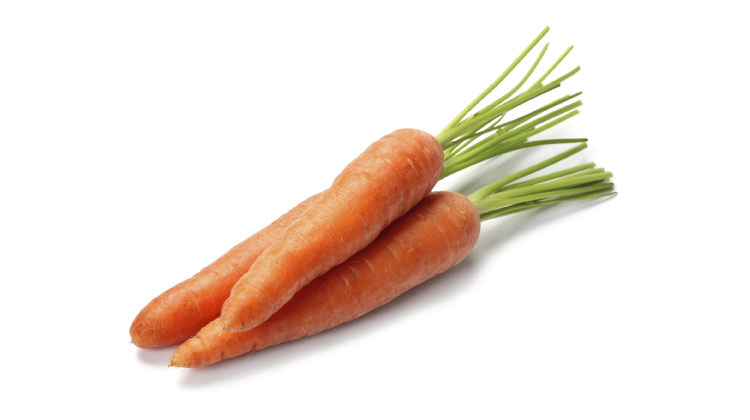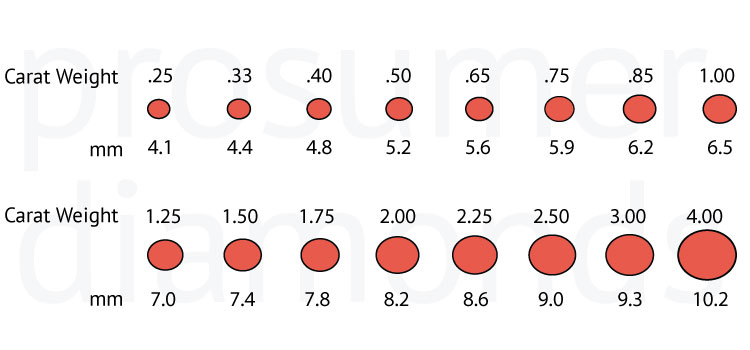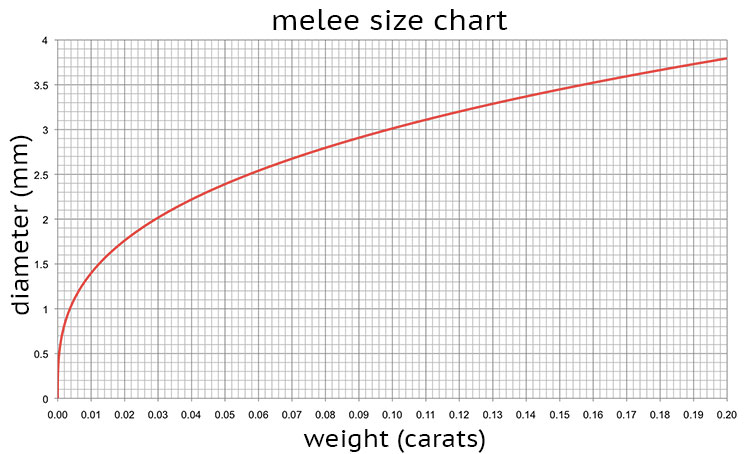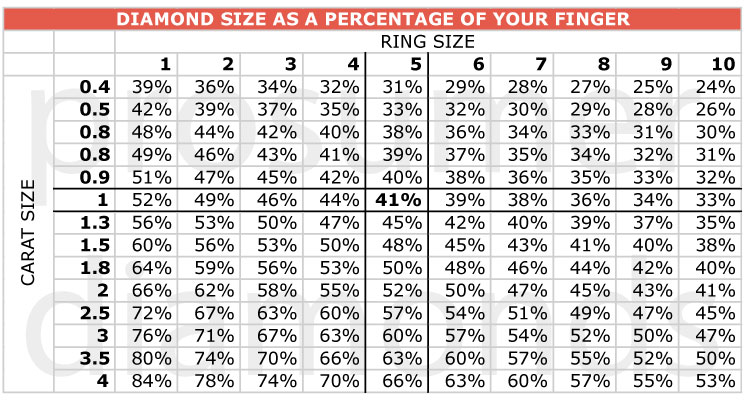
When it comes to diamonds, size matters. It’s not only because the size of the diamond is what people see first, but also because a larger diamond allows more light to enter the diamond through its table and crown facets just like how larger windows lets more light into a room. A larger diamond is therefore going to be a brighter diamond.
A larger diamond will also sparkle more because it will have more internal reflections. You can think of the table and pavilion facets as a house of mirrors creating an infinite number of internal reflections. A larger diamond causes more reflections and this is important because it is these reflections that generate the sparkle in a diamond.
Carat vs Cut
A larger diamond is something most people can appreciate and in many cases it makes a diamond more impressive looking. But much is made of the cut quality of a diamond and without doubt, the toughest trade-off you will make is size vs quality. Now I can’t tell you how big a diamond you should get but I can tell you that for smaller diamonds (0.3 – 0.7ct), carat makes a huge difference to the beauty of the diamond so the argument for compromising cut is stronger.
Larger diamonds will benefit more from additional cut precision.
The tough part is that if you optimize a diamond for cut, there’s a good chance you will be paying a 20-30% premium over a diamond optimized for size. One thing you can do is to go out to a jewelry store and compare their best cut diamond with a diamond that is GIA Very Good in cut that is 20-30% larger. If you think you get more wow-factor from the bigger diamond, then it might be a good idea to consider optimizing your diamond for size.
How big is a carat really?
Unbeknownst to you, you’ve been slowly brainwashed since you were a child to believe that you need at least a 1ct diamond. But do you actually know what a carat is or how big a 1ct diamond should be?
A well-cut 1ct round diamond should be very close to 6.5mm in diameter and it weighs 0.2 grams. Imagine how difficult it would be to justify the 20-30% difference in price per carat between a 0.9ct and 1.0ct diamond using its diameter and weight in grams to describe the diamonds. We’re only talking about differences of 0.02 grams and 0.2mm.
Using carat (a measurement of weight) doesn’t tell you how big a diamond is. It’s like being asked how tall you are and replying that you’re 110 lbs. Using the diameter of a diamond is far more meaningful to describe how big a diamond is. Diamonds that are cut too deep will have a smaller diameter for its carat weight so a quick way to check whether a diamond is well-cut is to see if it has the right diameter for its weight.
Diamond Size Charts
Here are a few diamond size charts for you to quickly reference. Please note that the charts assume a diamond without a girdle that has a total depth of 60% so most diamonds will be slightly smaller than the size stated on the chart.
If you have a certain size you want to aim for, you can use this formula to estimate the carat weight of an ideal modern round brilliant cut diamond:
Carat = Length(mm) x Width(mm) x Height(mm) x 0.0061
You can also use the chart below to find out how big a diamond will look with your finger size.
If you don’t know her ring size, then you should try to find out now. Do yourself a favor and don’t guess. Hopefully you are still early on in your search and you can plan to find this out without ruining the surprise. In many cases, it’s better she knows that it’s coming but not when!
Here are some good options for you to find out her ring size:
- Take her to a jewelry store and have her finger professionally sized.
- Ask one of her friends to help you find out.
- If she ever wears a ring on the ring finger then use that ring for reference.
- Propose with a loose diamond in a loose-stone holder ring and then pick out the setting together.
- Use a ring for her middle finger as reference but make sure you can have the ring easily resized.
The Right Carat
It’s possible for a 1ct diamond to have a smaller diameter than a 0.8ct diamond if it’s cut poorly. On top of this, poorly cut diamonds are more likely to have poor light performance as well so that they are physically smaller and also look smaller than they should be because of their optics.
When looking for an ideal-cut diamond, not only are you trying to find a diamond that has the correct size for its weight, you should also ensure that the proportions are within my recommended range. For more information you can read my article on how to pick a round diamond.
Price Per Carat Bands
When searching for diamonds you should pay attention to the price per carat (ppc) because you will notice that for a particular color/clarity combination the prices do not increase linearly. Rather there are price jumps that occur at certain carat sizes. The ppc bands are divided into the following ranges:
- 0.30 – 0.39ct
- 0.40 – 0.49ct
- 0.50 – 0.69ct
- 0.70 – 0.89ct
- 0.90 – 0.99ct
- 1.00 – 1.49ct
- 1.50 – 1.99ct
- 2.00 – 2.99ct
Each range is further subdivided into the following ranges, which may trade at an additional 5 – 10% ppc premium:
- 0.60 – 0.69ct
- 0.80 – 0.89ct
- 0.95 – 0.99ct
- 1.25 – 1.49ct
- 1.70 – 1.99ct
- 2.50 – 2.99ct
The .30, .40, .50, .70, .90, 1.0, 1.5, and 2.0ct marks are commonly referred to as the magic numbers. Because of the significant ppc difference beyond each magic number, there is a huge amount of economic pressure for cutters to save a diamond from finishing below these ranges. Ultimately this is why diamonds are not all cut to super-ideal standard.
An understanding of this pricing structure will help you understand why you can’t find well-cut diamonds in certain carat sizes. A piece of rough that would finish as a 1.4ct super-ideal cut diamond would be bid up by another cutter who would cut it deep so that it would finish above the 1.5ct mark that is more profitable. In practice, these diamonds are simply not cut because it is not economically feasible.
Well-cut diamonds in the following ranges will command an additional 10 – 20% premium:
- 0.35 – 0.40ct
- 0.45 – 0.49ct
- 0.60 – 0.69ct
- 1.35 – 1.49ct
- 1.8 – 1.99ct
- 2.75 – 2.99ct
It follows from this analysis that diamonds forced over the magic number mark command a lower price premium in addition to having a worse cut and potentially poor light performance. What this has done to the market is that almost all 2ct virtual diamonds are forced diamonds. The implication of getting a false 2ct diamond is that you either have to trade off the spread of the stone or the light performance. Getting a false 2ct diamond when your expectations are that you’re getting a true 2ct stone is one of the biggest mistakes you can make so consider yourself warned.
An interesting fact is that a diamond will only be rounded up to 1ct if it is 0.999cts. Can you imagine what would happen to the cutter if he ended up with a diamond, which was 0.998cts? Although you will probably not find a diamond that is 0.998cts, this demonstrates that it is possible to save some money by avoiding these price jumps by purchasing a diamond that weighs just under these magic numbers. In essence you are exploiting the inefficiencies of the diamond market.
However, as demand for diamonds that are just shy of the magic numbers increase so have their prices so well-cut diamonds that are 0.95ct+ are often priced very close to 1ct pricing. This means you probably should not worry too much about using this strategy to save money. Trying to find a good deal in diamonds is often a fools journey and it is more important to understand how everyone involved is making money to ensure you’re not going to get burned.
If you want to find a diamond that is the right size and want help making sure the diamond you buy isn’t hiding any weight, just send me an email and I’ll be happy to take a look for you.


